These notes were written by Eric and amended by Jean. Eric took most of the photos and Jean took others. All photos were selected, cropped, and inserted into this file by Jean. Factual information was taken from various sources including tourist brochures; we do not guarantee its accuracy.
Click on a photo to see a full size version. Not recommended for readers on dialup connections — some of these files are between 1 and 2 MB. Photo album from this part of the trip (more photos than shown on this page) starts here.
Monday 9 February 2009: Mavora Lakes tour
Concerned about a long drive to the place where we were meeting our tour guide today, we were up and packed, had eaten a hot breakfast at the hotel, and were on the road to Roxburgh through rolling but dry sheep country, before 8 a.m. It was even a good road.
We made good time, however the overcast soon turned to rain, so our speed decreased. We had no navigation problems and were refuelling in the major town of Gore at around 10 a.m. We note with amusement that almost directly east of Gore is the smaller town of Clinton. You can not make this stuff up!
We reached Lumsden by 11 a.m. By this time we knew we would have no problems with our schedule, so we hung around for some time. However the rain did not decrease. If anything, it simply got heavier.
Mossburn was the last town we passed through. After our lunch of bread rolls and ham and cheese, Eric returned to the cafe to buy an ice cream. Who could resist an Orgasmic Organic Chocolate Climax with Saucy Ripple? Naturally it could hardly live up to its billing.
We continued on to the second turn off to Mavora Lakes Road, 29 km down the road, where we stopped on the gravel verge behind an unidentified four wheel drive vehicle. This contained John von Tunzelman, our tour guide. We followed him to a nearby house, as a safer place to leave our hire car. Then we all set off in the rain in his four wheel drive, along a gravel road to South Mavora Lake. This is one of two lakes fed by the Mararoa River, the other being the larger North Mavora Lake.
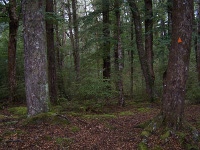 John was a former deer hunter who had worked for the Department of Conservation as a head ranger. One of his assignments had been to oversee Peter Jackson’s film production crew for Lord of the Rings in the Mavora Lakes area. He spent six weeks with them to ensure filming did not cause problems for the environment. He soon discovered that the film crew were most responsible, so most of the assignment John could spend observing how film makers operated.
John was a former deer hunter who had worked for the Department of Conservation as a head ranger. One of his assignments had been to oversee Peter Jackson’s film production crew for Lord of the Rings in the Mavora Lakes area. He spent six weeks with them to ensure filming did not cause problems for the environment. He soon discovered that the film crew were most responsible, so most of the assignment John could spend observing how film makers operated.
John took us to the locations used to film Fangorn Forest and Nen Hithoel. We visited the Orc Hobbit chase scenes area, and walked around the log where the Hobbits hid. John also showed us the location where Gandalf whistled for his horse Shadowfax. The Lake actually stood in for the river during the film. John also showed us the location of the filming of the heap of burning Orc bodies. Of course, this was accompanied by many stories of events during the filming.
 John also had his own stories of working as a ranger. Two dangerous trees near a camp site, and a work crew about to fell them. One could be dropped safely into the forest. The other had to fall across the camping area. Only one small tent in the way, with bicycle tracks around it. They picked up the entire tent still erect, and carried it safely out of the way. Then they felled the tree. Chainsawed a large section out of the middle of the tree, and returned the tent to the gap in the fallen tree. Alas, they had to continue working elsewhere, and never did see the reaction of the returning campers.
John also had his own stories of working as a ranger. Two dangerous trees near a camp site, and a work crew about to fell them. One could be dropped safely into the forest. The other had to fall across the camping area. Only one small tent in the way, with bicycle tracks around it. They picked up the entire tent still erect, and carried it safely out of the way. Then they felled the tree. Chainsawed a large section out of the middle of the tree, and returned the tent to the gap in the fallen tree. Alas, they had to continue working elsewhere, and never did see the reaction of the returning campers.
John was wonderful value as a tour guide, as well as being helpful and friendly. He and his wife run a bed and breakfast in Te Anau.
We followed John into Te Anau, and he kindly led us right to our self-contained apartments, Campbells on the Lake. John told us it was a nice place, and it certainly was. Twelve one-bedroom units, with nice lounge rooms and a self-contained kitchen. Reception handed Jean an Ethernet cable, and told us WiFi was also free (try the front of the lounge).
Since there was no restaurant or food service, we drove through the rain to a supermarket a few blocks away. We stocked up for a few breakfasts, and dinner that evening. Before long we were back at the apartment, getting stuck into our wine. We also had a proper dinner, for pie sized portions of dinner.
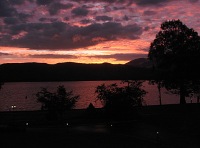 The rain eventually stopped, as John had promised. The clouds and moisture provided a wonderful sunset from our room at Campbells on the Lake overlooking Lake Te Anau. We took photos.
The rain eventually stopped, as John had promised. The clouds and moisture provided a wonderful sunset from our room at Campbells on the Lake overlooking Lake Te Anau. We took photos.
WiFi reception from the Zenbu network was much as promised. Eric logged his iPhone in and quickly checked outstanding email. Then he read some of the news of the Australian bush fires. Must be serious; even the politicians have stopped sniping at each other for the moment.
Tuesday 10 February: Milford Sound
We were driving to Milford Sound by 7:45 a.m., to ensure arrival before our cruise departed. We were delayed a while in leaving by the need to wipe the rain and condensation off the car windows. Naturally we had no cloths for that purpose.
It was cold in the morning, but wonderfully clear. We had to run the car heaters for most of the trip to keep the windows clear of condensation. Eric’s feet didn’t warm up until after we ended our drive. Jean did all the driving.
 We tried to photograph the light on the small clumps of cloud flanking the hills. There were some wonderful light effects there, perhaps too subtle for the camera.
We tried to photograph the light on the small clumps of cloud flanking the hills. There were some wonderful light effects there, perhaps too subtle for the camera.
Every now and them we plunged into dense rain forest. The amount of light dropped dramatically. Then we would emerge to mountain scenery, complete with snow or ice, or something that appeared cold and white.
Eric finds the concept of snow in the middle of summer to be truly bizarre. Then he reflected that these areas are twice our home distance from the equator. Indeed, New Zealand is halfway to the South Pole. We passed the 45 degree sign on this trip. Plus we live at sea level, whereas much of New Zealand has real actual mountains. The landscapes were formed by genuine glaciers.
Milford Sound is a mere 120 kilometre drive from Te Anau, partly through Fiordland National Park. The guidebooks say to allow two to three hours. There are several good reasons it is a slow trip. You will probably stop frequently for photographs. We certainly did. The road is very steep and winding after you get halfway to Milford Sound. Passing is close to impossible for long stretches, and there are many tourist buses and campervans on the road. In addition, there is a long, single land road tunnel with a 15 minute wait for the lights to cycle.
Concerned about our available time, we did not stop at Eglinton Valley to check the Reflecting Pools. Upon our return, the wind had disturbed the water and they were no longer reflecting. The ducks didn’t help any either.
We reached the parking lot at Milford Sound at about 9:55, with 15 minutes to spare before ticket collection. However the walk from the parking lot to the boats was ten minutes.
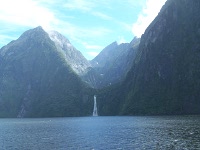 Real Journeys was the tour operator. The boat was well equipped. We had purchased the lunch option. The weather was beautiful, though a bit cool by our standards. Jean was happy, because on her only other visit to Milford Sound (in 1976), the fog was so thick she could hardly see the surrounding mountains.
Real Journeys was the tour operator. The boat was well equipped. We had purchased the lunch option. The weather was beautiful, though a bit cool by our standards. Jean was happy, because on her only other visit to Milford Sound (in 1976), the fog was so thick she could hardly see the surrounding mountains.
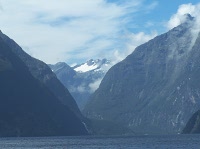 What can you say about such a magnificent place? We saw dolphins and seals and lots of waterfalls. The cruise ended all too soon.
What can you say about such a magnificent place? We saw dolphins and seals and lots of waterfalls. The cruise ended all too soon.
Driving back to Te Anau, we stopped at several of the interesting spots that we skipped on the way out. Back at Campbells on the Lake, Eric did our laundry while Jean rested from the drive.
Eric’s walk along the foreshore and the central shopping area of Te Anau showed a pleasant and tidy town, with heaps of tourist facilities. Apart from the obvious boat trip booking agents, there was a seaplane anchored a little offshore, advertising sightseeing trips. The town had several garden parks with seats for tourists to sit and eat. There were a number of eating places, as well as bars. It reminded him a lot of Airlie Beach, but perhaps more upmarket.
He also spotted the cinema that shows their tourist film about the Fiordland area. Several people had recommended that film. However it was too far for Jean to walk that evening, and did not open in the morning until 10 a.m. What he should have done was bought the DVD.
We wasted a fair amount of time on the free internet. As well, we transferred all our photos into our computers.
Wednesday 11 February: Te Anau to Queenstown
Manapouri was our first stop, although a diversion away from our destination. This is a little lakeside resort village about 20 km south from Te Anau. It is not on Lake Te Anau, but on Lake Manapouri. It was a very pretty little resort town, with tourist boat rides.
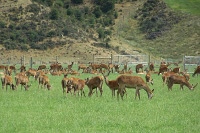 We took the Hillside Manapouri side road that rejoined the road to Mossburn. Deer were the thing Jean wanted to see along the way. We sighted several fields full of deer along the way, and were often able to stop to photograph them. They always seemed to keep their distance, unlike some other farmed animals. Even when the deer were not in sight, we could tell which fields were for them: the fences were 2 or 3 times as high as for cattle or sheep.
We took the Hillside Manapouri side road that rejoined the road to Mossburn. Deer were the thing Jean wanted to see along the way. We sighted several fields full of deer along the way, and were often able to stop to photograph them. They always seemed to keep their distance, unlike some other farmed animals. Even when the deer were not in sight, we could tell which fields were for them: the fences were 2 or 3 times as high as for cattle or sheep.
As we approached Mossburn, we could see the nearby windfarm on top of the ridge. Eric sighted at least 16 wind turbines. Being in the Roaring ’40’s, New Zealand is a good place for wind turbines. Wind is also a good match with hydroelectric power, as water can be turned on rapidly when the wind dies down.
Stop at Mossburn at 11:30 a.m. for a snack and rest break. It proclaims itself the deer capital of the South Island. We took another short cut from here onto the road to Queenstown.
 Garston was our lunch stop. Lunch consisted of leftover ham and cheese (well, a cheese-like pre-sliced substance in individual serves). There was a pleasant park at this small town, with nice views as well. We did not leave Garston until 1 p.m. We were taking it slow, with many stops for photographs.
Garston was our lunch stop. Lunch consisted of leftover ham and cheese (well, a cheese-like pre-sliced substance in individual serves). There was a pleasant park at this small town, with nice views as well. We did not leave Garston until 1 p.m. We were taking it slow, with many stops for photographs.
Fairlight had the railway station and tourist shop for the end of the Kingston Flyer steam train run. Naturally we stopped to check the station.
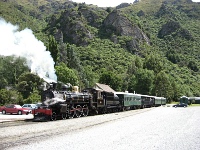 At Kingston, and the southern end of Lake Wakatipu, was the home of the Kingston Flyer steam train, nestled next to an impressive hillside beside the lake. The Kingston Flyer was making an impressive amount of steam. It was hauling three carriages. It made for a wonderful performance as it pulled away from the station and headed for Fairlight. The station is also very neat, with a nice bar as well as the ticket sales and tourist shop.
At Kingston, and the southern end of Lake Wakatipu, was the home of the Kingston Flyer steam train, nestled next to an impressive hillside beside the lake. The Kingston Flyer was making an impressive amount of steam. It was hauling three carriages. It made for a wonderful performance as it pulled away from the station and headed for Fairlight. The station is also very neat, with a nice bar as well as the ticket sales and tourist shop.
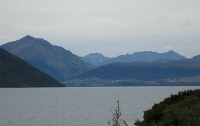 The Devil’s Staircase is the numerous twists and turns of the road along the edge of Lake Wakatipu towards Frankton and Queenstown. We stopped at the Halfway Bay lookout to take photos of this shallow bay halfway along Lake Wakatipu between Kingston and Queenstown.
The Devil’s Staircase is the numerous twists and turns of the road along the edge of Lake Wakatipu towards Frankton and Queenstown. We stopped at the Halfway Bay lookout to take photos of this shallow bay halfway along Lake Wakatipu between Kingston and Queenstown.
At Frankston, we came to a total halt. House on road. Well, more accurately, a decent sized wooden house on a very large flat-bed transport organised by King House Removals. Must be a fairly frequent things to move wooden homes here. The house could barely fit around some roundabouts and bridges. Police escorts were pulling oncoming traffic entirely off the road. Many delays due to this, until it pulled off the road on the outskirts of Queenstown. Fortunately we were not in a hurry.
Queenstown overlooks Lake Wakatipu. It seemed almost as if every house clung to a steep hillside in quest of a water view. Eric had some trouble following the Google map Jean had printed out, but his wild guesses eventually led us pretty much straight to the Buena Vista motel.
Traffic was incredible, and we had some trouble getting the car to the right driveway. We eventually realised it was parents collecting school children from the primary school a short distance down the road from our motel.
Paragliders were jumping off the peak above us, which was served by a cable lift. Two landed in the small park next to the motel while we were moving the car in. When Eric went for a walk later, he counted seven in the air, and watched another two land.
Eric searched Queenstown for suitable food and finally found a Four Square supermarket where we could get fixings for breakfast. Luckily that was not too far away. Unfortunately, he found it only after walking all over Queenstown, including down as far as the lake.
We had a delicious (and expensive) meal at Brazz Bar diner, on Athol Street and Ballarat Street, off to the side of the main street of Queenstown. Jean had lamb medallion with eggplant, capsicum, chick peas and yoghurt sauce. It was heaped and gigantic. Eric had two tapas: breaded fried camembert with cranberry sauce, and beef skewers with mint yoghurt. There were three skewers, and seven camembert. I should have stuck with one dish.
We found some Sacred Hill Pinot Noir in The Wine Thief Series at Betty’s Bottle shop on the main street, so we bought two bottles. Eric had asked at their other shop in town, without finding that particular Sacred Hill. Indeed, he had asked at most bottle shops in town.
Page last updated 7 July 2009.
